Domènec Torrent’s stay at New York City FC ended with the announcement and introduction of coach Ronny Deila. Hailing from Europe, Deila has built his coaching resume around coaching clubs such as Celtic, Strømsgodset, and, very recently, Vålerenga.
While his coaching stays at Vålerenga and Celtic weren’t as successful, he has garnered a reputation of being called the Norwegian ‘Jurgen Klopp’. So how will Deila perform at New York City FC?
In this tactical analysis, we present you a head coach analysis on Ronny Deila and what tactics he’ll bring to NYCFC. We’ll do an analysis on his playing styles and his philosophy that he aims to bring to the MLS club.
Deila’s unique understanding of half-space and centre-space
A lot of coaches focus on exploiting the three basic types of space in the football pitch: wing-spaces, half-spaces, and central corridor. All types of tactics essentially focus on manipulation on these types of spaces and the consequent exploitation of these spaces.
Lining his team in a 4-4-2, Deila and his attacking style focuses on the central space and later we’ll talk about how he exploits them. For now, it is important to analyze how Deila opens up space in the first place.
Deila is unique in his philosophy as he constantly aims to work in the half-spaces to exploit the central corridor. The half-space is unique for Deila for many reasons. Firstly, it allows his team to have access to both the central and wing corridors with great ease. In addition to lateral flexibility, the halfspace is a great zone for those curving through balls to the wing or to the centre.
This lateral and longitudinal flexibility that the half-space affords his players is important because it allows Deila’s team to play to Deila’s preferred method of attacking: fast-paced, aggressive, and fluid. Having control over half-spaces facilitates this method of play as it allows multiple runs to be made the team as a whole.
Knowing that the half-space is in control, the attackers can start making early runs and play fluidly to be involved in combination play, knowing that they will already have their creative players in this key space.
In addition to facilitating his style of play, control of half-spaces also allows Deila to pry open the central space.
The first method/step in accomplishing this goal is by constantly switching flanks. At his time at Vålerenga, Deila had his players constantly looking for long, diagonal switches of play. In addition to these general switches, which were often made by deeper players, Deila’s tactics also accompany short switches of play. A short switch of play involves when central midfielders took a generally concentrated play and spread it out to the winger.
While many teams do this as their secondary method for attacking, Deila uses the spreading out of play as the first step for attacking. Switches of play allowed his team to take control of wing scenarios where 1v1 situations would be set up.

Here we see the centre block of opposition in a very narrow formation. As such, the Vålerenga player in the centre makes a long pass to the wings – switching the play. The reason for these types of passes is explained in the picture below.
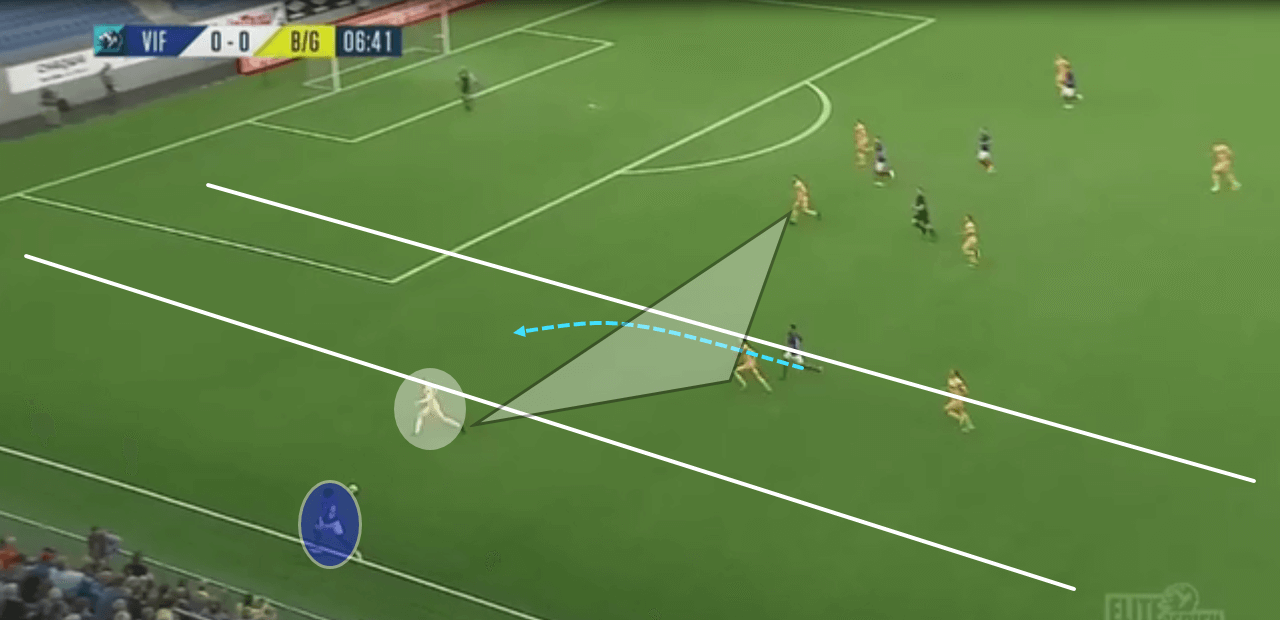
Here the winger, shown in blue, has received a ball from a long switch. He is in a 1v1 duel against the opposition full-back. Playing wide and dragging the defender out, he has created space in the half-space, shown in white. As soon as this space is created, we see his teammate run to occupy this space and allow for Deila’s tactics to come to fruition.
This is where the 4-4-2 comes into play as the two strikers up top can often split to allow these scenarios to become overloaded. After having switched the play to the wing, Deila has his players establish numerical dominance near the wing-space and half-space.
This allows his men to play intricately in such a small place and as a result, draw in the formation in such a way that the opposition defence starts to break away and lose rigidity. This interplay allows his teams to create space in the centre – whether in the box or outside the box – and in a quick manner, start attacking from the centre.
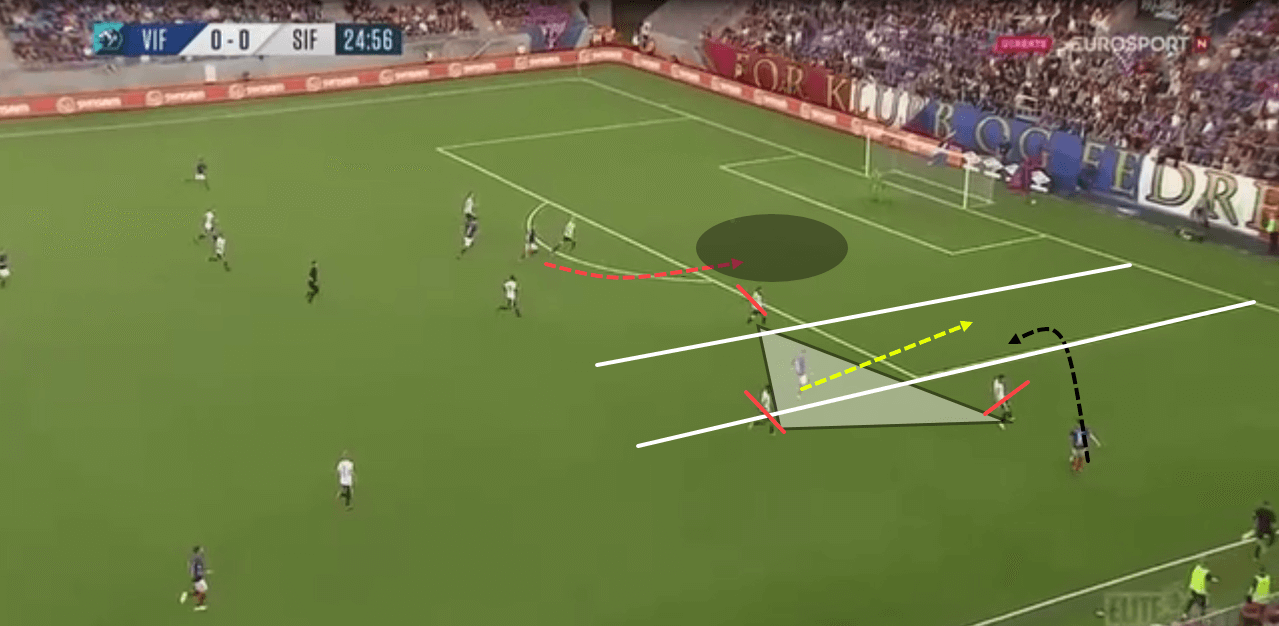
Here we see exactly why Deila wants control of the half-spaces. With a 1v1 situation created on the wings, the winger is able to carve out space in the half-space, shown in white. This spce is occupied by a runner who will receive the ball in plenty of space.
Due to the nature of the half-space, the strikers know that the incoming service is going to be good. As such, we see the striker start to make a curved run to exploit the widening gap centrally that has been created due to Deila’s tactics.
In addition to the quick combination play, positional tactics, and switches, Deila also utilises a constant inversion on the wings to overload the half-space and yet again, dominate the space. Often times, the full-backs, when receiving the ball, will come inwards and turn centre. This is usually combined with a movement from a nearby midfielder to come into the half-space.
This movement not only crowds the half-space but also awkwardly bunches the opposition defence making them being caught being fully and half committed to defence. This now opens up space for Deila’s wingers or strikers to occupy that space.
Since Deila’s men have control over the half-space and are now attacking on the wing, the defence is abnormally shifted to one side which opens up the defensive formation of the opposition and allows the centre to open up.
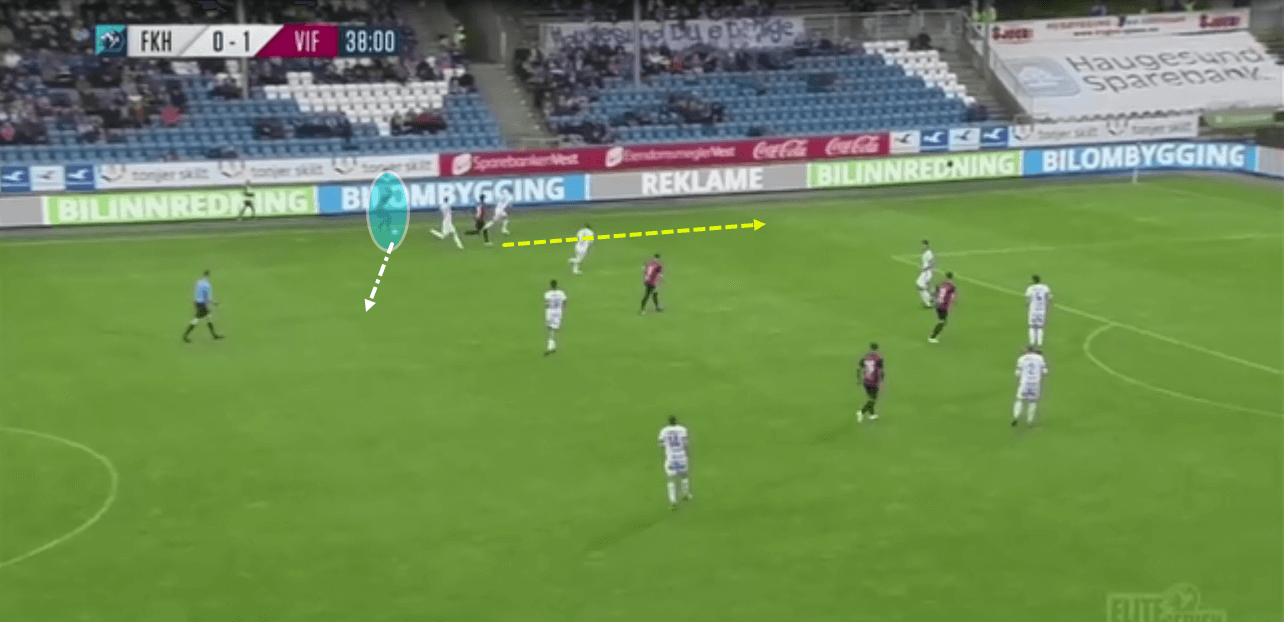
In this example, we see the full-back making an inward run into the half-space while the winger runs forwards. The opposition defenders are taken by the wingers’ run leaving the half-space free. In a short while, we will see the full extent of this inversion.
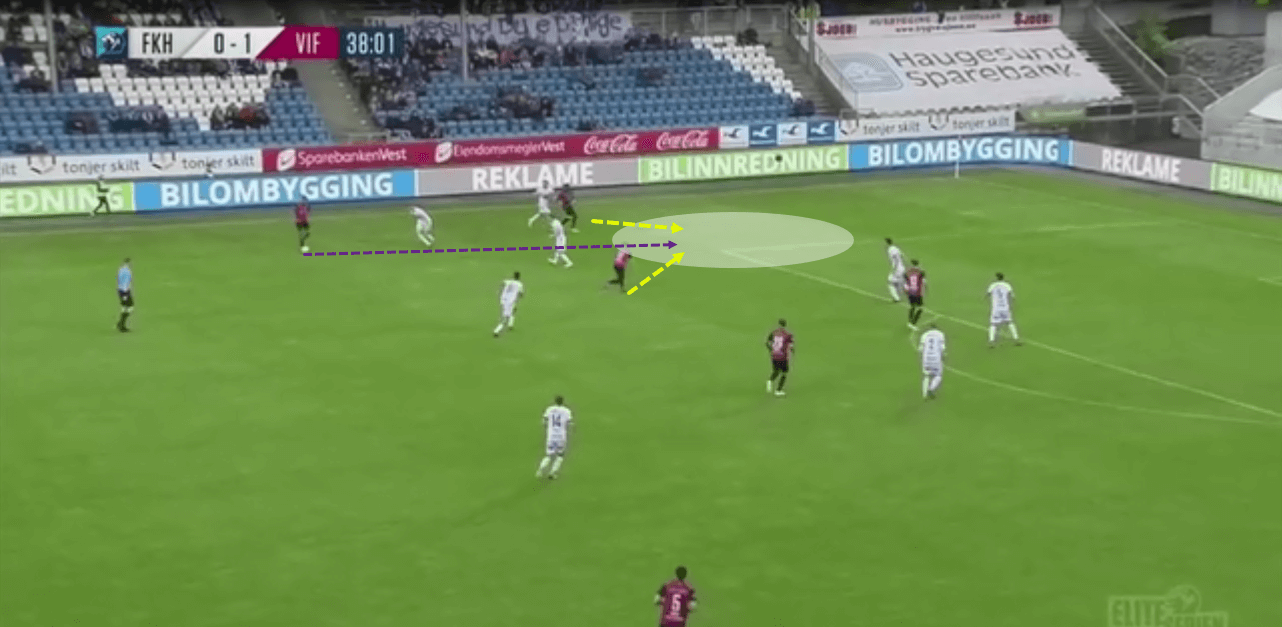
With the inversion of the positions, space had been created. Now due to the runs, the positioning of the defence is such that a simple pass will penetrate the defence allowing Deila’s men control of half-space in the final third. With two players ready to commit to the pass, Deila’s men are dangerously working their way through.
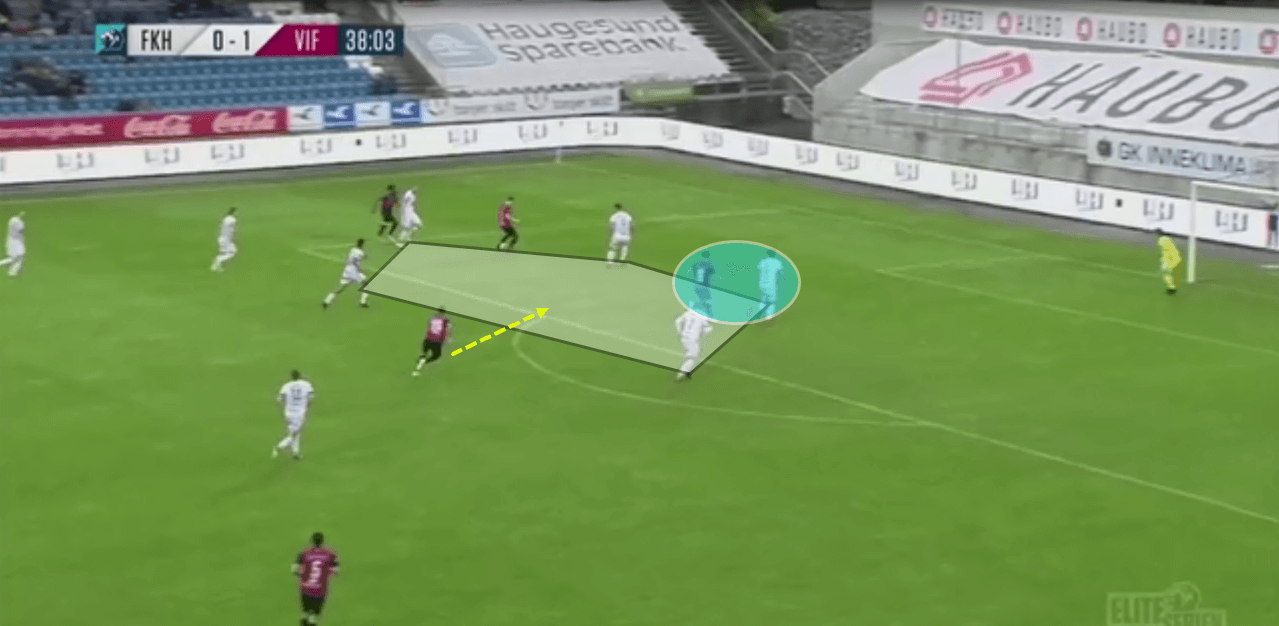
With the ball being dribbled in the half-space, we see the first striker pinned by a centre-back. However, this is following Deila’s plan as the striker will make a decoy run to give space to the late-arriving midfielder.
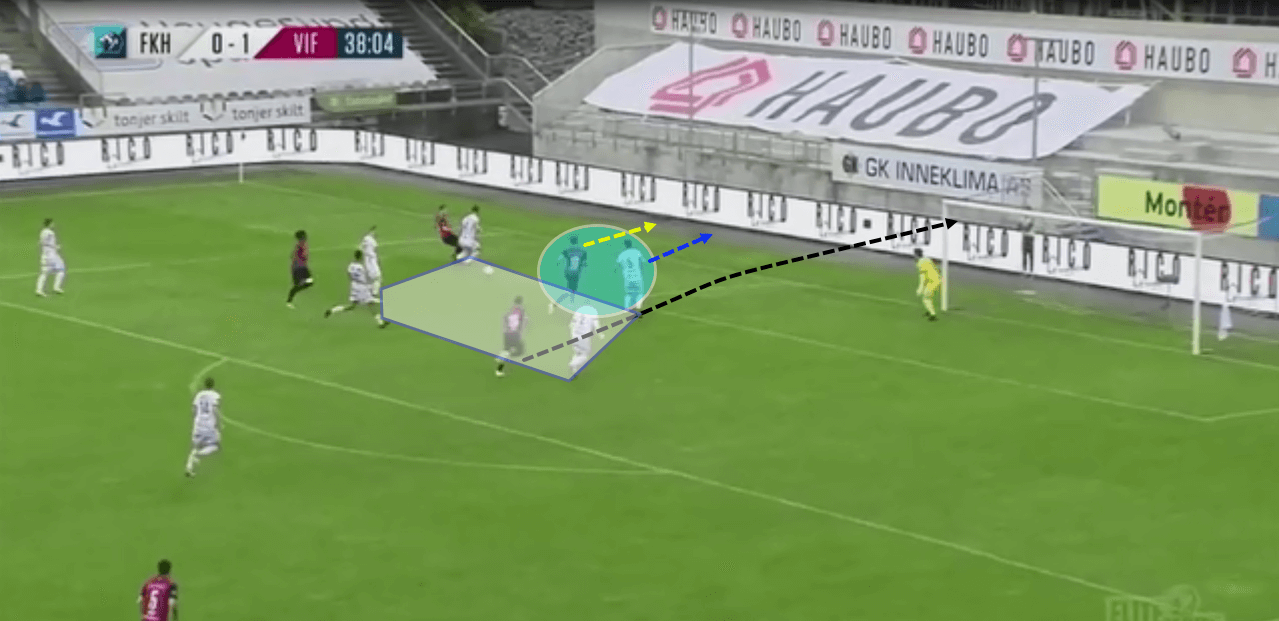
Here we see the decoy run of the striker creating more central space. Having created space in the centre, the late-midfielder is now able to have enough factors in his favor to score a goal.
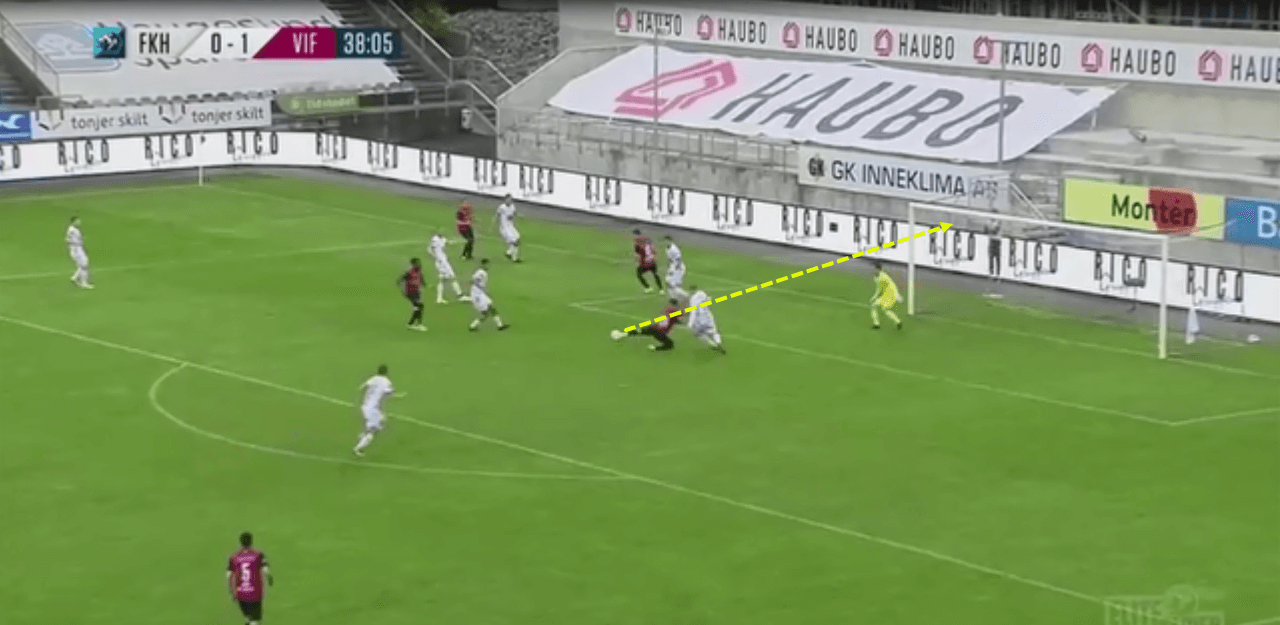
Here is the final effect of the principle we have talked about. With space in the centre, Deila’s player is able to get a shot on target, despite slipping, and converting it into a goal.
Deila’s unique approach in crossing-play
Having carved out the space in the centre, Deila aims to attack that space in a way that is unique and innovative: attacking centre through the wings. While at first it seems like a normal tactic – every team attacks the centre through the wings.
However, Deila is distinct in that his teams’ primary method of attacking seems to be through the wings. The main obstacle in this pathway is that attacking pathways from the wings start to become very one-dimensional and easily defendable.
However, Deila makes sure there is enough variance and variety in his players’ movements and types of play. From all the wingplay, Deila’s two common methods of attacking centre is through low-crosses, cut-backs, and general crosses which also include corners. Each one method of attacking has its own nuance which we’ll explore each in nuance.
The first one we’ll explore are general crosses which also include corner play.
In general corner-play, Deila’s tactic has his two strikers near the goalkeeper. Behind these two strikers, there is a block of four players that are near the penalty spot. At the time of attacking the cross, the strikers stay rooted with minimal movement while the block of four players start making individual runs into the box.
A common movement from these four players is for some to head to the posts while some to crowd the centre. This movement is effective in destabilizing in defence with an odd-looking formation that allows the striker to effectively attack the ball.
In other variations of the movement, it allows them to overload the back post to attack the ball with more precision.

Here we see the two distinct blocks from Deila’s men. The front two strikers occupy themselves near the goalkeeper while a block of four occupies the space behind them. This structure allows the midfielders to run in variable ways, as seen by the numerous possibilities and really does not allow the defence to predictably defend.
The positioning of the two strikers near the goalkeeper also makes it hard for the goalkeeper to claim any balls that land in that area – which they do. This forces a majority of the defence to clump around to add protection but this only works in favour of Deila’s tactic as it makes it harder for the goalkeeper to claim again.
This forces a man-marking with the block of four where Deila often asks his players to mismatch in size or to making different runs to make one player free.
Another way Deila attacks corner kicks is by putting his players right near the goalkeeper and then having another set of attackers near the near post. This type of positioning makes it very hard for the goalkeeper to do anything.
In addition, the number of players near the near post increases the probability that the random movement of the ball in relation to the players will ping-pong across and allow Deila’s players to push the ball and score.
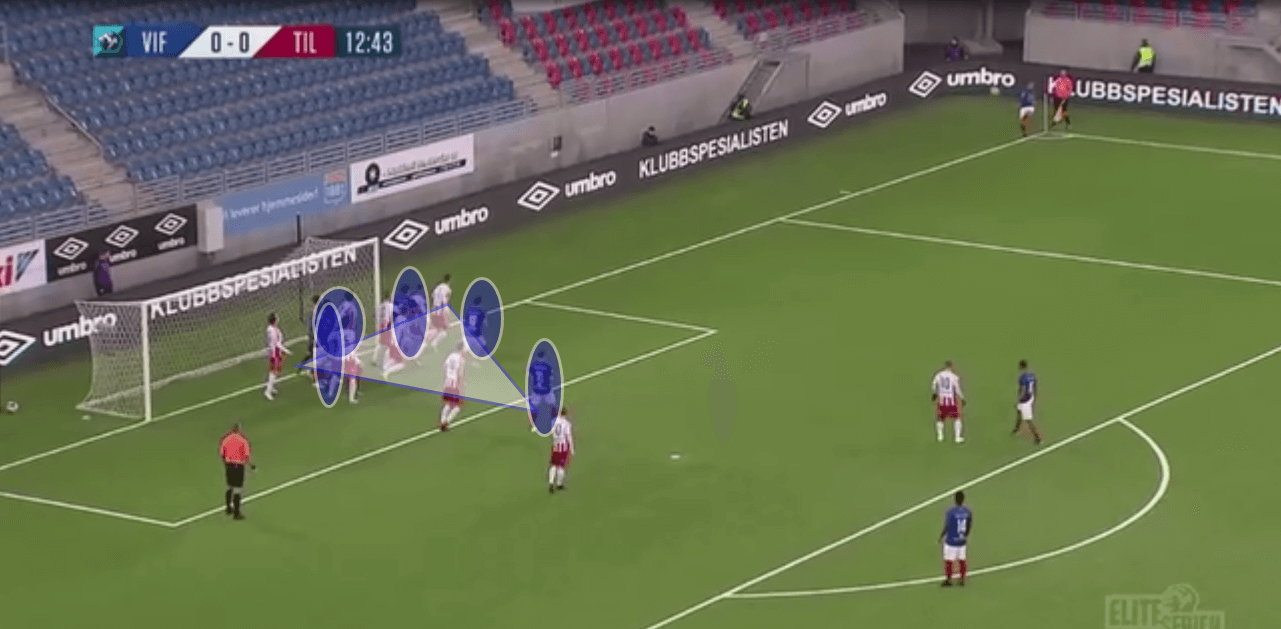
Here we see an arrow-shaped structure from Deila’s men. By putting more men behind than forward, Deila’s tactics form a natural shield of sorts preventing the goalkeeper from doing anything. This allows the up-front attackers to freely attack the ball and increase the chances of them scoring a goal.
While this neat set-up allows Deila to have a general gameplan while also introducing variation into his attacking play, in general, crossing play from the wings, the strategy is less complicated yet retain its effectiveness.
One of the main advantages of having a two-striker system is that it allows them to maintain the attention of the defenders. Deila uses this to great effect, having his players at Valerenga often stay in one line and run forward when the full-back gets in the final third.
Then, both the full-back and the strikers play a special play – the full-back keeps looking for space behind the defence. This is because Deila wants one of his strikers to suddenly separate from his partner to create space in the centre in the defence.
This separation is accompanied by an “anchoring” by the other striker. This allows Deila’s players to have the defence concentrate on the second striker for some more seconds which allows the attacking striker to strike the ball in some space.
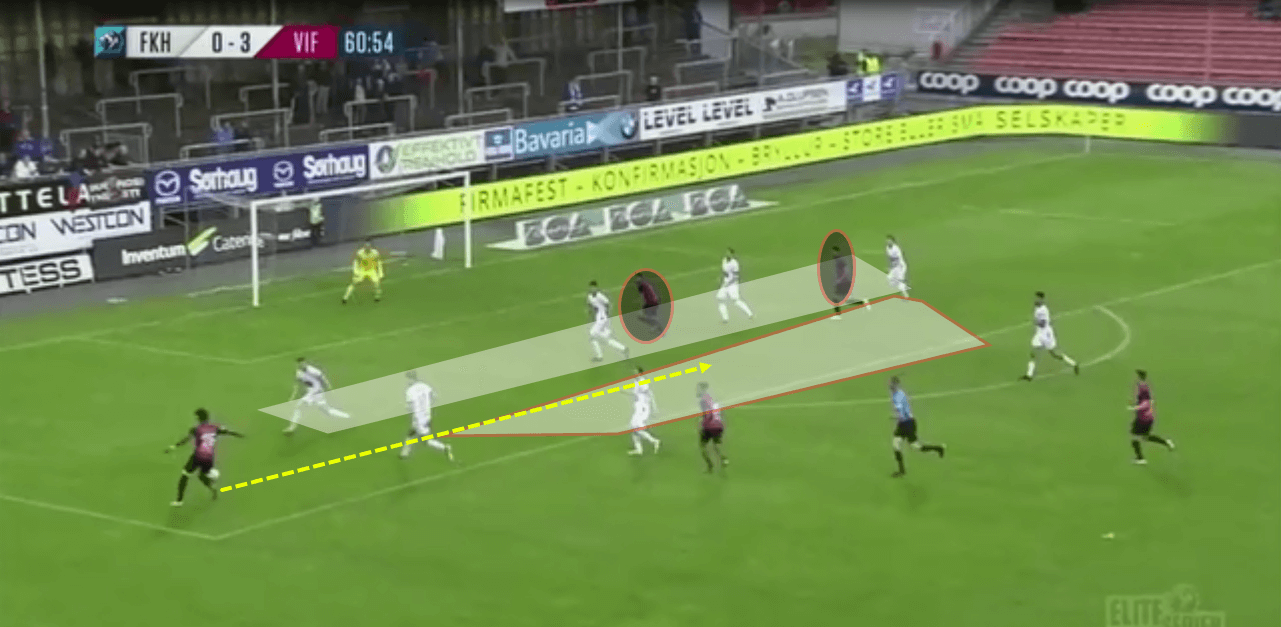
Here both strikers keep the defensive line deeper creating space between the midfield and defence. The full-back can place a cross in the space knowing that one of the strikers will drop down and attack the ball.
In addition, Deila keeps the general principles of crossing in his crosshairs making his team have multiple runners when crossing from deeper positions and having the cross land in the central space – the area where the defence has to make a hesitation in their defence.
Deila’s low-cross and cut-backs create havoc for opposition
Deila also cleverly utilizes low crosses and cutbacks to exploit his central space creation. This method of attacking the centre space introduces enough variability into the attack to keep the defence guessing. So what are Deila’s philosophy behind low crosses and cutbacks?
We’ll start with cutbacks as the variations and scheme of doing cutbacks is very complicated and reflects Deila’s attention to the details.
There are two stages for a cutback according to Deila. The first step is pre-cutback and the second is the actual cutback. This type of breakdown allows us to more closely analyze Deila’s attacks.
The pre-cutback normally occurs in the half-space and for good reason. As discussed before, Deila’s tactics allow for his team to control half-spaces. As such, it makes sense for these cutbacks to occur in the halfspaces. Moreover, a halfspace afford Deila’s players the ability to run down the length of the half-space.
By doing this, Deila is able to shift the opposition defence deeper than they’d like. This creates more space for the receiver for the cutback. Additionally, this tactic also allows Deila’s player to find better angles for the cutbacks.
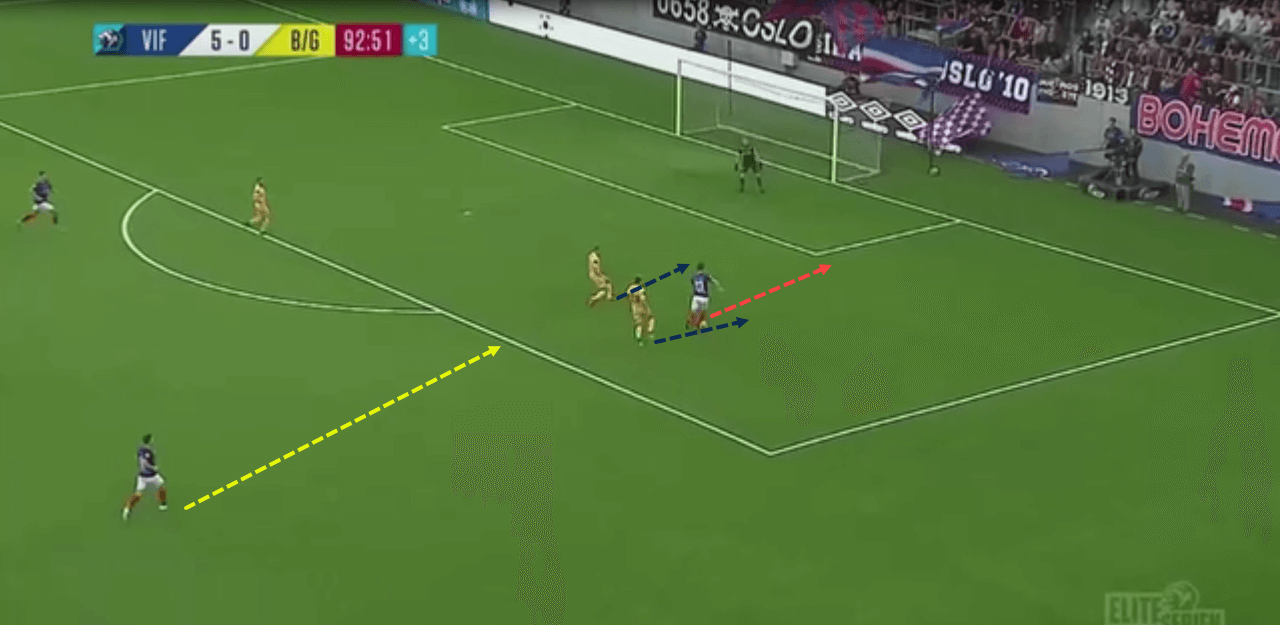
Here we see a player go deeper into the half-space which drags the two nearby defenders deeper. This creates space and if one notices, there is a late run being made into the box. This will set up the incoming cut-back.
After having perfected the pre-cutback, Deila has his players who will receive the cutbacks to arrive late. These late runs into the box means that the defence doesn’t know what is hitting them until it hits them.
In combination to the late runs for the cutback, Deila also asks various players to make fake runs for the cutback, dragging opposition defenders from the central space. This also the cutback to be more effective, and consequently, more deadly.
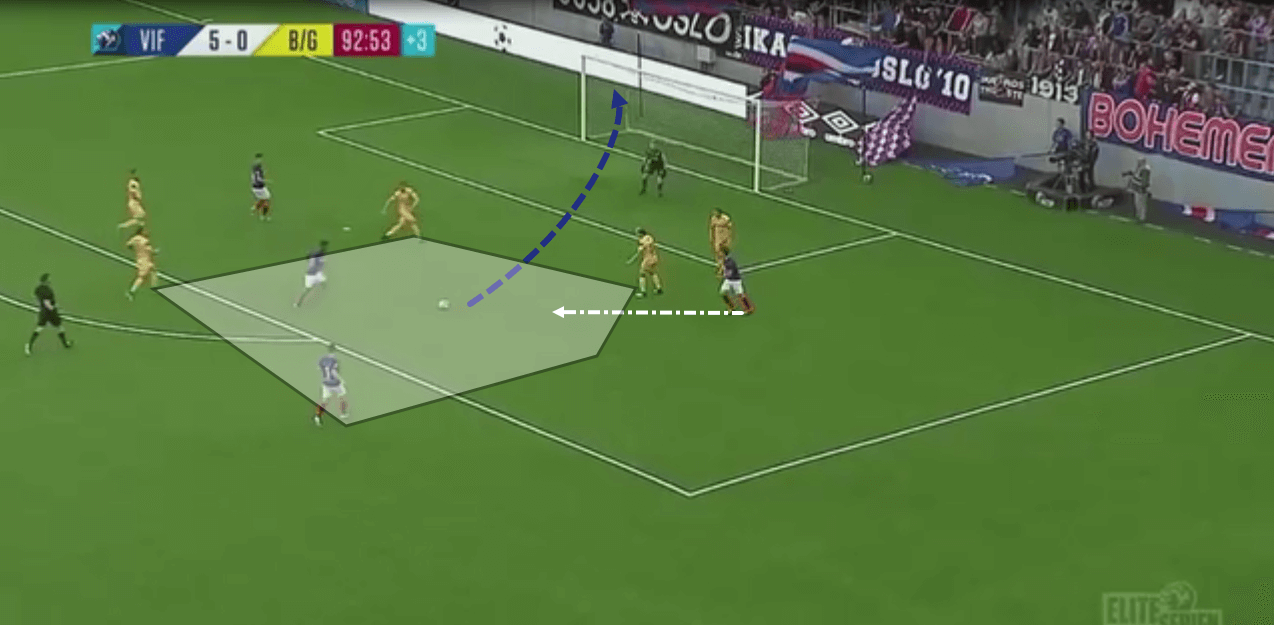
Here we see the cut-back tactics come to life. Due to the pre-cutback tactics, space has been created in the centre. With this creation of space, the recipient has enough factors to curl the ball and score a goal.
Deila also places emphasis on low crosses however not to the same effect. The basic structure for a low cross is that the strikers will get close to the goalkeeper. Like others, this has the effect of dragging the defensive line deeper which, again, creates space in the centre. Deila then has late midfield runs into the centre with various players shielding the arriving player from potential defender actions.
Deila’s weaknesses in defending half-spaces
Deila normally sets out his team to defend in a 4-4-2 formation – as many other managers have done. However, where they succeed, Deila fails.
The main failure of Deila in his defensive tactics, which was particularly evident at Vålerenga, was that Deila’s 4-4-2 is too open than a 4-4-2 should be. In particular, Vålerenga constantly struggled defending their own halfspaces, an aspect which is ironic, with the relationship between their centre-backs and full-backs too loose than a coach would like.
The 4-4-2 from Vålerenga was at times too open with the lines being not as compact. This is particularly because of Deila’s attacking preferences. As such, opposition attacks often found it easier to bypass the forward and midfield lines.
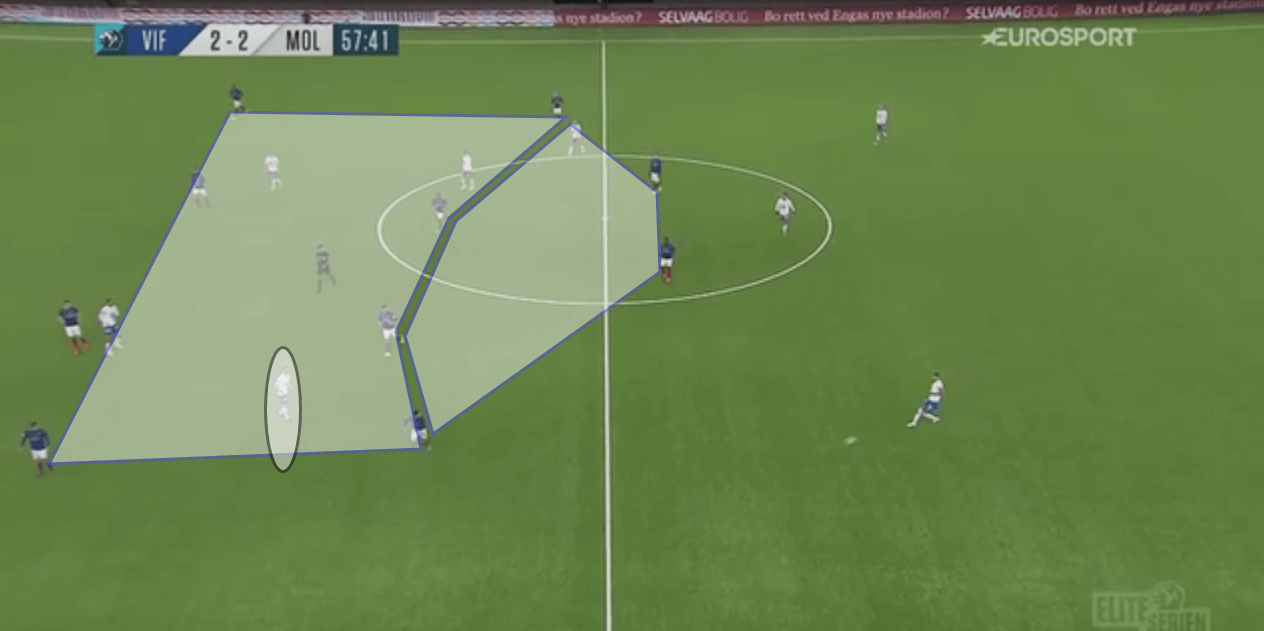
In this 4-4-2 formation that we see from Deila’s men, we see just how open it is. The space between the midfield and defence is too big – something which is shown by the player in the white circle. He is in too much space and may cause problems
However, the bigger problem for Deila at Vålerenga was that his tactics were ineffective at adding security to his team’s half-space. His 4-4-2 is often times placid which means that the full-backs and centre-backs are overwhelmed when the team creates wing overloads.
The main inability for this is because of Deila’s midfield at Vålerenga. The interior midfielders are caught lacking ball-watching and are not able to man-mark the occupiers in the half-spaces or at least temporarily mark them.
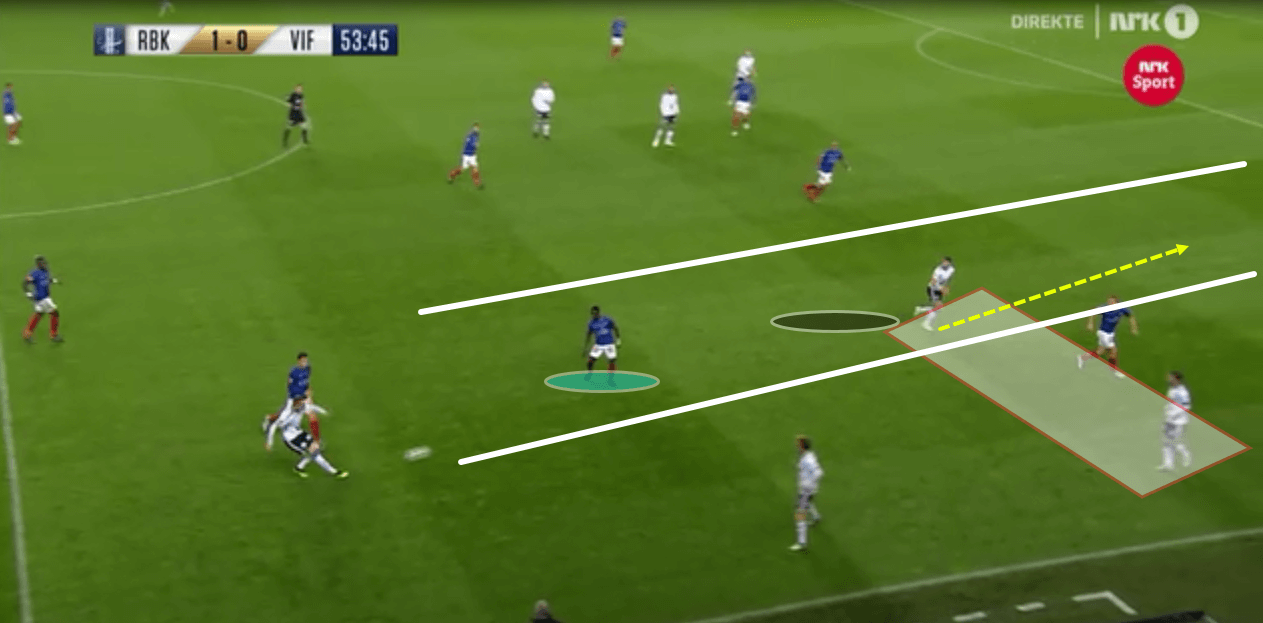
Here there is a 2v1 situation on the wing. This wing overload does not allow for the full-back to defend the incoming ball into the half-space.
The interior midfielder, shown in blue, should be closer to the defence. This impulsive positioning means that the attacker in the half-space is free to roam forward and as such, Deila’s men have few measures to defend against this.
Combining this inability to defend overloads and an open formation, the half-space between the centre-backs and full-backs is exploited by too many teams. Making this scenario worse is the fact that the teachings for the defensive line was not as expected as Vålerenga’s defensive line was either too impulsive leaving space behind or being too deep.
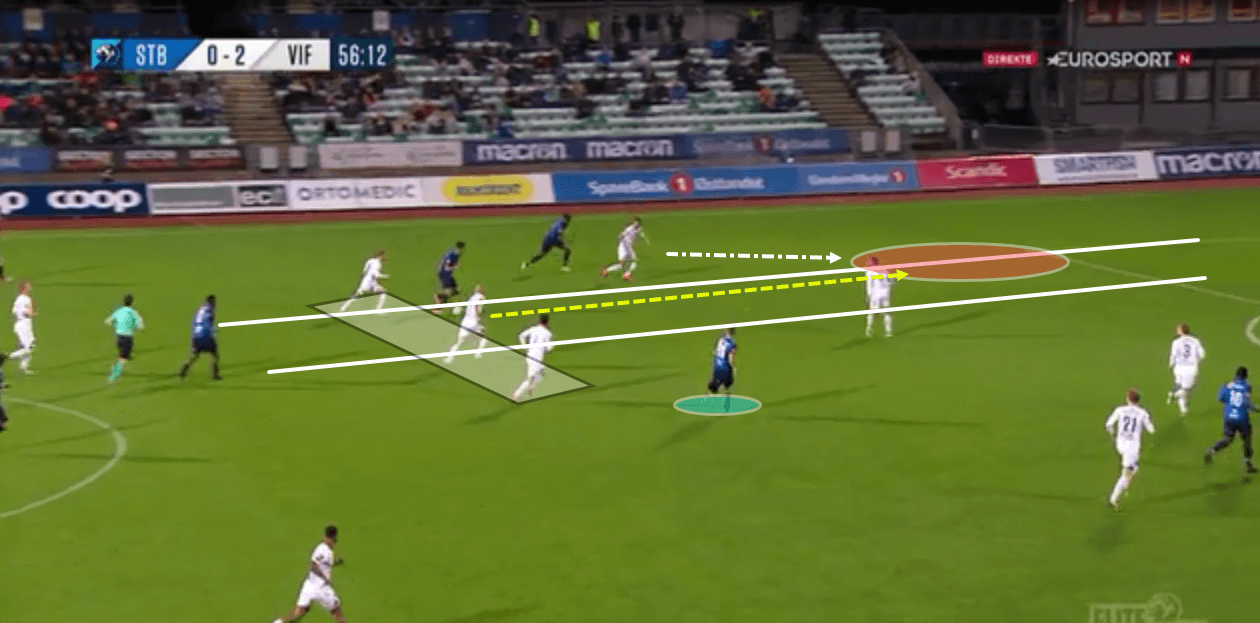
Here we see half-space being opened again. The positioning of the interior midfielders, shown in white, is not conducive for defence as they are all bunched in position. This opens the half-space and allows for a through-ball.
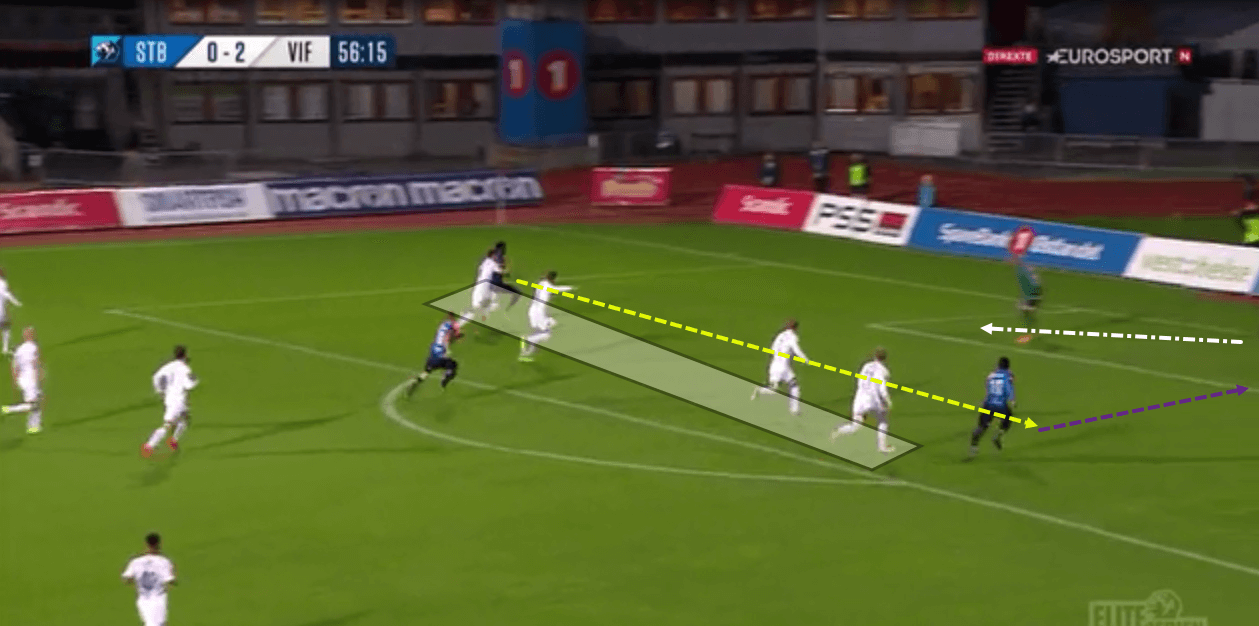
The defensive line comes upfield too early allowing for an easy low cross to take place and an easy goal to be scored.
While the quality of his players is definitely not as adequate, Deila also shows that he is not as strong in defence as we can see his failure to fix the squad profiles or tactically tweaking to fix that scenario. We are allowed to make this conclusion seeing that Deila has been in charge at Vålerenga for three years – an ample period of time to implement his philosophy.
Conclusion
Deila is an interesting figure as a coach. His times at Celtic and Strømsgodset have been successes while his tenure at Vålerenga has been a mix of success and failure. In terms of MLS, NYCFC seems like a good destination for the budding, attacking, and unique manager.
Through the tactics and analysis, we’ve seen his meticulous eye to detail and his unique attacking ideas make it such that NYCFC are getting an attacking-minded coach who will bring something unique, tactically, that the rest of the league has not witnessed.




Comments